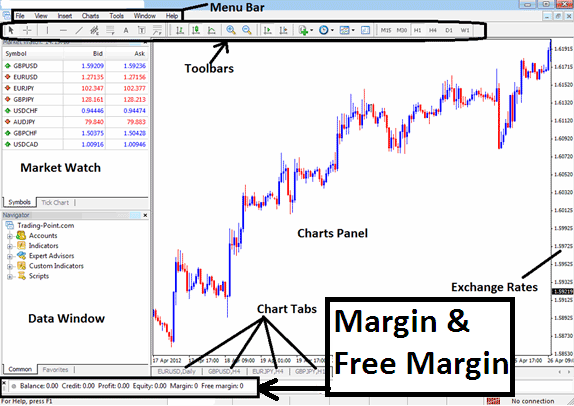FX Leverage & Margin Example - Leverage & Margin for Mini Account Explained
Forex Leverage & Margin Example Explained
Margin required : It's amount of money your broker requires from you as a trader to open a trade. It is conveyed in percentages.
Equity : It's total amount of capital you've in your trading account.
Used margin : amount of money in your account which has already been used up when buying a currency lot, this contract is one that is illustrated and displayed in open trade positions. You can not use this amount of money after registering and opening a trade order transaction because you have already used it and it's not available to you.
In other terms, because your broker has opened up a position for you using capital you have borrowed, you must preserve this usable margin for your account as a collateral so as to allow you the trader to continue using this leverage that the broker has given to you.
Free margin : amount in your account that you as a trader can use to open new positions. This is amount of money in your trading account that hasn't yet been leveraged because you have not yet opened a trade transaction with this money - this money also is very important for you as a investor and trader because it facilitates you to continue holding your open positions as will be explained below.
However, if you over use leverage, this free margin will drop below a certain % at which your broker will have to stop out all of your transactions automatically/mechanically, leaving you with a big loss. Broker at this point closes out all your trade because if your transactions were to be left open they would lose the money you have borrowed from them.
This is why you should always make sure you've got a lot of free margin. In order to do this as a trader never trade more than 5 percent of your account, in fact 2 percent is recommended.
Difference Between Leverage Set by the Broker & Used Leverage
If the set leverage is 100: 1, it means that you as a trader can borrow upto $100 for every 1 dollar that you have in your account but you do not have to borrow all the $100 for every $1 you've, but you as a trader can decide to borrow 50:1 or 20:1. In this case even though the leverage option set 100:1 your used leverage will be the 50:1 or 20:1 which you have borrowed to make a trade position.
Example:
You have $1000 dollars (Equity)
Set 100:1
Leverage Used = Amount used /Equity
1 Mini Lot, 10,000 Mini Lot
If you buy one Mini lot which is equivalent to 10,000 dollars you will have used
= 10,000/1000
= 10:1 leverage
0.5 Mini Lot, $5,000 Dollars Mini Lot
If you buy one 0.5 mini lots which is equal to 5,000 dollars you'll have used
= 5,000/1000
= 5:1 leverage
0.2 Mini Lot, $2,000 Mini Lot
If you buy one 0.2 lots which is equal to 2,000 dollars you'll have used
= 2,000/1000
= 2:1 leverage
In these 3 cases you as a trader can see that though the set max leverage is 100:1
The used leverage option is 10:1, 5:1 and 2:1 depending on the position size of lots traded.
So Why not Just Choose/Select 10:1 leverage option as the Maximum Leverage? Because to keep within the suitable risk management principles it's even recommended that traders use less than this?
This question might seem straight forward but it is not, because when you trade you use borrowed money known as Leverage. When you borrow capital from anyone or a bank you as a trader must maintain security or collateral to acquire a loan, even if the collateral is depending on the monthly deduction from your own wages, same thing with Trading.
In trading the security is referred to as margin. This is the capital which you deposit with your broker.
This is calculated in realtime as you trade. To keep your borrowed money you as a trader must sustain what is referred to as the required capital (your deposit).
Now if Your Trading Leverage is 100:1
When trading if you have $1,000 & use option 100:1 & buy 1 Mini lot for $10,000 your margin on this trade is $1000 in your trading account, this margin is the money that you will lose out if your open trade moves against you - the other $99,000 dollars that's borrowed, the online broker will close the open trades mechanically/automatically once your $1,000 has been taken by the market.
But this is if your broker has set 0 % Margin Requirements before closing outliquidating your trade positions automatically.
For 20% margin requirement before stopping out your open trades automatically, then your trades will be closed out once your account balance reaches $200
For 50% margin prerequisite of this level before closing out your transactions automatically, then your trades will be closed out once your account balance gets to $500
If your broker sets 100% margin requirement of this level before closing out your open positions automatically/mechanically, then your open trades will be automatically closed once your account balance gets to $1,000: Meaning that the trade will be closed-out as soon as you the trader executes it because even if you pay 1 pips spread your trading account balance will get to $990 & the needed percentage is 100 percent i.e. $1,000 dollars, therefore your trade orders will immediately get stopped out out.
Most online brokers don't set 100% requirement, but there are those brokers who set 100% are not suitable for you at all, choose those set 50% or 20% margin requirements, in fact, those brokers who set at 20% are some of the best because the likely hood they stop out-out your trade is minimized like displayed in above example.
To know about this margin level which is calculated by your MT4 software automatically - the MT4 Platform Software will indicate this as "Margin Requirement", This will be displayed as a percentage the higher the percentage the less likely your transactions are to get stopped out.
For Examples if - (using a broker that requires 20 % margin requirement)
Using 100:1 leverage
If leverage is 100:1 and you transact 10 Mini Lots, equals to $100,000
$100,000 dollars divide by 100:1, your used funds is $1000
Calculation:
= Capital Used * Percentage
= $1,000/$1000 dollars * Percent(100)
Margin Requirement = 100%
Investor and Trader has 80% above required margin trading level amount
Using 10:1
If leverage is 10:1 & you transact 1 Mini Lot, equals to $10,000
$10,000 divided by 100:1, your used funds is $100
Calculation:
= Capital Used * Percentage
= $1,000/$100 * Percent(100)
Margin Requirement = 1000%
Investor and Trader has 980% above required margin level amount
Using 1:1 leverage
If leverage is 1:1 and you transact 0.1 Mini Lot, equals to $1,000
$1,000 dollars divide by 100:1, your used capital is $10
Calculation:
= Capital Used * Percentage
= $1,000/$10 * Percent(100)
Margin Requirement = 10,000%
Investor and Trader has 9800% above required margin trading level amount
Because when one has got a higher leverage means that they have more margin requirement percent above what is required(A.K.A. More "Free Margin") their open trades are less likely to get liquidated. This is reason why traders will choose option 100:1 for their account but in accordance to their risk management guidelines, they won't trade above 5:1 leverage option.
These Margin Levels are Shown on the MT4 Platform Software Screen Shot Below as an Example:

MT4 Software Margin and Free Margin - Leverage & Margin for Mini Account Explained
Study More Tutorials & Courses:
- Kauffman Efficiency Ratio Trading Indicator Example Explained
- What Indices are Traded on the MetaTrader 4 Forex Software?
- SP 500 SP 500 Index Opening Hours
- How Can I Use MT4 McGinley Dynamic Technical Indicator?
- How Can I Use MetaTrader 4 Trend Trigger Factor TTF on MT4 Platform?
- XAGEUR Opening Time and XAGEUR Closing Time
- How to Save MetaTrader 5 Chart Template in MT5 Platform


